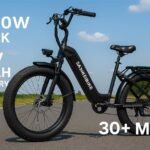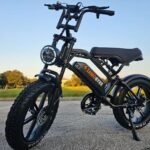Enjoy your ride, every day counts!
![Is the Tamobyke V20 Worth It? Real-World Power, Battery & Ride Feel ([year]) Is the Tamobyke V20 Worth It? Real-World Power, Battery & Ride Feel](https://goebikelife.com/wp-content/uploads/2025/09/Tamobyke-V20-Electric-Bike-Review.jpg)
![Is the Tamobyke V20 Worth It? Real-World Power, Battery & Ride Feel ([year]) Tamobyke V20 4.0 moped-style electric bike with 20x4.0 fat tires](https://goebikelife.com/wp-content/uploads/2025/09/Tamobyke-V20-Electric-Bike.jpg)
Tamobyke V20 Electric Bike — Moped-Style Power & Comfort
Our take: torquey 750W hub (2000W peak), dual suspension and a removable 48V battery make this mini-moto a fast, cushy daily rider.
- 750W rear hub (peak 1500–2000W) hits 28–33 mph; confident hill-climb torque.
- Dual suspension + 20×4.0 fat tires for stable, comfortable city, trail & snow rides.
- Removable 48V 15.6–18.2Ah battery, UL safety, lights + turn signals, horn & alarm.
- Motor
- 750W (peak 1500–2000W)
- Battery
- 48V 15.6–18.2Ah
- Top Speed
- 28–33 mph
- Range
- PAS up to 34–68+ mi
If you’re shopping for a moped-style e-bike that looks tough, rides comfortably, and doesn’t obliterate your budget, the Tamobyke V20 4.0 is going to catch your eye. It combines a long bench seat, dual suspension and fat 20×4.0-inch tires with a punchy 750W (1,500–2,000W peak) rear hub motor and a removable 48V battery. The headline numbers—28–33 mph top speed and a PAS range that can stretch beyond 60 miles—promise a lot for the money.
The V20’s personality is part mini-moto, part everyday commuter. It’s built on a sturdy carbon-steel frame, uses dual disc brakes (many listings and current units ship with hydraulics), and layers in thoughtful touches like turn signals under the rear seat, a loud horn, and a large headlight. The brand also touts UL battery safety and IPX-rated protection for peace of mind. On paper, it looks like a versatile do-it-all bike for city streets, dirt paths, and snowy boardwalk mornings.
This review walks through what the V20 is really like to live with—how it accelerates, climbs, and stops, how comfortable that long saddle is on rough pavement, how far the 48V 15.6Ah (or optional 18.2Ah) pack really goes, and who should pick it over more traditional step-through commuters. I’ll be candid about what shines and what doesn’t, so you can decide with confidence.
Is the Tamobyke V20 for you?
The V20 solves a simple problem: you want the look and stance of a compact moped-style e-bike, but you also want go-anywhere utility. Fat 20×4.0 tires and dual suspension make potholes and gravel much less scary. The bench saddle is roomy for taller riders or for short trips with a smaller passenger. And the motor’s surge lets you keep pace with city traffic in short bursts while still climbing steep neighborhood hills without drama.
It’s a strong fit if you commute 5–15 miles each way, mix urban pavement with park trails, or want a single bike that can handle beach paths, snow dustings, and errand duty. Riders in the 5’6″–6’4″ height band will find the fixed 33.8-inch saddle height most comfortable. Heavier riders (up to 330 lb rated load) will appreciate the stout frame and torquey hub.
It’s not for everyone. If you need a super-light bike you can carry up multiple flights of stairs, the V20’s 83–98 lb system weight will test your patience. If you’re strict about legal Class 1/2/3 compliance where you ride, note that a 30+ mph throttle is outside many jurisdictions’ limits—and you may need to re-limit the bike via settings. Nor is this the ideal choice if you want road-bike agility or feather-light pedaling feel; it’s a mini-moto, and it rides like one.
Budget-wise, the V20 sits firmly in the value tier. You’re getting motor power, battery capacity and suspension features that often cost more. Beginners can absolutely start here—the upright stance, stable tires and clear display help—but expect a brief learning curve with the weight, power levels and brake feel.
What We Like About the Tamobyke V20
The motor tuning is the star. Rated 750W with a 1,500–2,000W peak, the rear hub spools up briskly and holds speed well on rolling terrain. In throttle-only it will surge to neighborhood speeds quickly; in PAS it feels stronger still because your pedal cadence wakes the controller immediately. On long grades, it doesn’t fade as fast as many budget hubs in this category. The bike claims “45° up slop” with pedaling—ignore the exact angle, but torque on modest climbs is genuinely confident.
Battery options add real range flexibility. The base 48V 15.6Ah pack is sufficient for most commuters; ride in PAS 2–3, keep speeds in the low-20s, and 35–50 miles is achievable for an average-weight rider on mixed terrain. Step to the 18.2Ah pack and careful PAS use can stretch into the 50–60+ mile zone. The removable pack is UL-safety claimed and IPX-rated, and the 54.6V charger is simple to use at home or the office.
Comfort is meaningfully better than hard-tail, small-wheel moped bikes. The dual suspension soaks up broken pavement, curb cuts and hardpack chatter. Combine that with wide 20×4.0 all-terrain tires and a long, thick bench, and you get an easygoing ride that encourages longer trips. Fat tires also expand your playground: a little snow or beach sand no longer means “leave the bike home.”
The V20’s safety kit is surprisingly complete. You get dual disc brakes (many units hydraulic), a big headlight, integrated tail/brake light, under-seat turn signals with bar-mounted control, and an electronic horn loud enough to cut through city noise. The included alarm key-fob allows lock/unlock and sensitivity/volume settings—handy anti-tamper insurance on quick store runs.
Finally, the design looks great. The frame blends retro-moto cues with modern cutouts, and the stealth-black battery sits neatly in the down-tube window. Cable routing is tidy, the mag wheels look tough, and the whole bike has a “small motorcycle” vibe that turns heads without shouting.
What We Don’t Like About the Tamobyke V20
Weight is the tax you pay for that comfort and power. Even without the battery, you’re lugging an 80-plus-pound bike. With the battery installed and accessories on, many units tip closer to the high-90s. If your daily routine includes stairs or tight hallway pivots, plan accordingly.
The bench seat height is fixed around 33.8 inches, which favors medium to tall riders. Shorter riders can manage thanks to the fat-tire stability, but you won’t flat-foot the bike at stops unless you slide off the saddle. There’s also no telescopic seatpost adjustment—customization is limited.
Brakes are strong, but quality can vary by batch and spec sheet. Some product pages call them “double hydraulic,” others “double mechanical.” My take: most recent shipments use hydraulics, but rotor size and pad compound are basic. They stop a heavy bike, yet you won’t get premium modulation under repeated hard braking on long descents. Budget for better pads or larger rotors if you’ll ride steep hills regularly.
The drivetrain is a 7-speed Shimano freewheel with a cadence sensor—simple and reliable, but not as “natural” as a torque-sensor system. At very low speeds, PAS 1 can still feel a touch eager; at high speeds the gearing tops out, giving a “hamster-wheel” spin above ~25 mph. None of this is a deal-breaker at this price, just know how it rides.
Quality control and documentation are decent but not flawless. Translation in the manual is rough around the edges, and cable grommets and accessory plastics feel cost-conscious. The included lock and phone mount are useful but basic; many riders will upgrade. Lastly, out-of-the-box speed settings can exceed local e-bike classes—make sure you configure the controller to match your laws and comfort.
Pros & Cons
| Pros | Cons |
|---|---|
| Torquey 750W rear hub (1,500–2,000W peak) with quick throttle response | Heavy: 83–98 lb depending on battery and accessories |
| Dual suspension + fat 20×4.0 tires soften bad roads and trails | Fixed 33.8″ bench height favors medium/tall riders |
| Long-range removable 48V battery options (15.6Ah or 18.2Ah) | Cadence sensor pedaling feel; gearing spins out at higher speeds |
| Strong safety package: hydraulic (or mechanical) dual discs, headlight, brake/turn lights, horn, alarm fob | Brake spec and rotor size vary; modulation is just okay on long downhills |
| Roomy bench seat, mag wheels, clean wiring—great mini-moto look | Included lock/phone mount are basic; documentation is rough |
| UL-claimed battery safety and IPX water protection | Out-of-box top speed may exceed local Class 1/2/3 rules |
What’s Included?
- Tamobyke V20 4.0 e-bike (carbon-steel frame, 20×4.0 tires, dual suspension)
- Removable 48V battery (15.6Ah standard; some listings offer 18.2Ah)
- 54.6V battery charger (2A)
- Electronic alarm key-fob (lock/unlock, sensitivity, volume)
- Integrated headlight, taillight/brake light, and under-seat turn signals
- Bike horn with selectable sound profile
- Basic bike lock and phone holder
- Hand pump
- Tool kit and hardware for assembly (varies by batch)
- User manual and warranty card
Impressions of the bundle: At this price, the kit is generous. The alarm fob, lights, horn and phone holder make “day one” commuting easy. The included lock is better than nothing, but I’d still invest in a quality U-lock or chain for city parking. A rear rack or fenders aren’t always in the box—if utility is your priority, factor those into your first-month upgrades.
Technical Specifications
| Spec | Tamobyke V20 4.0 |
|---|---|
| Frame | Carbon steel, moped-style with integrated battery window |
| Wheel/Tire | 20×4.0 in all-terrain fat tires, mag wheels |
| Motor | 750W rated rear hub, 1,500–2,000W peak (brushless) |
| Top Speed | 28–33 mph (throttle), PAS levels 1–5 tuning available |
| Battery | 48V 15.6Ah (optional 48V 18.2Ah); removable; UL-safety claimed |
| Range (claimed) | Pure electric 25–34 mi; PAS 35–68+ mi (rider/terrain dependent) |
| Charger | 54.6V, ~2A; full charge ~5–7 hours |
| Drivetrain | Shimano 7-speed freewheel; 5-level throttle/PAS controller |
| Display | Digital LCD (speedometer, odometer, trip, PAS level, clock, modes) |
| Brakes | Dual disc (many units hydraulic); 2-piston calipers |
| Suspension | Dual: hydraulic front fork + rear shock |
| Lighting | Headlight, tail/brake light, under-seat turn signals; handlebar switch |
| Horn/Alarm | Electronic horn; remote alarm fob with sensitivity/volume control |
| Dimensions | Length 62″; handlebar height ~43.3″; saddle height 33.8″ |
| Weight | ~83.3 lb without battery; listings show up to ~98 lb with battery |
| Rider Height | Recommended 5’6″–6’4″ |
| Max Load | 330 lb |
| Water Resistance | IPX battery/weather protection noted |
| Warranty | 1-year warranty; 30-day return window (brand policy) |
| Certifications | UL battery safety claimed |
Features
- Moped-style design with long bench seat for stable, upright comfort and occasional passenger duty.
- 750W rear hub motor (1,500–2,000W peak) delivers quick launches and solid hill performance.
- Two battery choices—48V 15.6Ah standard or 48V 18.2Ah—for range up to 60+ miles in conservative PAS.
- Dual suspension system (hydraulic fork + rear shock) to smooth rough pavement and fire roads.
- Dual disc brakes—often hydraulic—for confident stopping on a heavy chassis.
- 20×4.0 fat tires add grip and plushness on dirt, snow dustings, and beach paths.
- Comprehensive lighting suite with bright headlight, tail/brake light, and under-seat turn signals.
- Bar-mounted horn and turn controls with an alarm key-fob for quick lock/unlock and tamper alert.
- Digital LCD display with speed, PAS level, odometer, trip and clock.
- 7-speed drivetrain and 5-level PAS to match effort and speed targets.
- IPX-rated protection and UL-claimed battery safety, plus BMS safeguards.
- Accessories included: phone holder, basic lock, and a compact pump.
My take on the spec sheet: The V20 emphasizes ride stability, power, and real-world convenience. You feel the heft, but that mass paired with fat tires and suspension translates to calm handling on sketchy surfaces. The motor/battery package is competitive with bikes hundreds of dollars higher. Where the spec shows its price is finesse—brake components, PAS smoothness, and small finishing touches. Still, for a value-tier moped-style, it over-delivers more often than not.
Ride Impressions
Acceleration & speed: Throttle response is immediate in higher PAS levels, and there’s enough mid-range to merge across lanes or clear intersections confidently. Expect 0–20 mph in a handful of seconds on level ground. Above ~28 mph you feel the power curve taper—unsurprising for a budget hub—but holding 23–25 mph into a headwind is easy.
Climbing: Short, steep neighborhood punches are the V20’s playground. Keep cadence steady in a middle cog, use PAS 4–5, and the bike hums uphill without bogging. On long 8–10% climbs, speed will drop, yet the motor hangs in better than many 750W peers.
Handling & stability: The fat tires and long wheelbase keep the bike planted. In loose over hardpack, drop pressure to the high-teens PSI and it tracks well. On pavement, 22–25 PSI offers a plush ride without excessive squirm. The steering is relaxed, not twitchy, and the bench lets you shift fore/aft to adjust front-rear weight on climbs or corner entries.
Braking: Stopping distance is good for a heavy bike, and lever feel is light with hydraulics. After a few hard stops, you’ll notice some fade if rotors are small; swapping to higher-friction pads is a cheap improvement. Mechanical-brake units require more hand force and careful setup—plan a quick tune after the break-in miles.
Comfort & fit: The bench is a standout for the category—long and thick enough that you can move around to avoid hot spots on longer rides. The fixed height is the limitation; riders under ~5’6″ will wish for an inch or two lower. Vibration through the bars is well-controlled thanks to the fork and tires, and the rear shock prevents spine-hits on square-edge bumps.
Noise & refinement: Hub whine is moderate and disappears under city noise. Chainline chatter is minimal once you set limit screws. Cable rattle is kept in check by decent routing, though a couple of extra zip ties never hurt.
Battery & Range Reality
Tamobyke advertises 25–34 miles on throttle and 35–68+ miles on PAS, depending on rider weight, terrain, and wind. Those numbers are within reason if you manage speed. At 20–22 mph in PAS 2–3, mixed urban terrain and an average rider can expect 35–45 miles from the 15.6Ah pack. The 18.2Ah option adds roughly 15–20% more.
Cold weather will trim range. Conversely, if you cruise bike paths at 15–17 mph in PAS 1–2, you’ll push toward the high end of the claims. Charging from low battery to full takes ~5–7 hours with the included 2A charger. As with all lithium-ion packs, keeping the battery between 20–80% for daily use and avoiding long storage at empty will maximize health.
Practicality & Everyday Use
Transport & storage: At ~83–98 lb, this is not a train-and-stair champion. A ground-floor apartment, garage or elevator will make life easier. The removable battery reduces carry weight by ~8–10 lb when you need to lift the frame.
Security: The included alarm fob is a nice deterrent during short stops. Pair it with a quality lock (or two) for city parking. The mag wheels resist spoke damage, but remember that fat-tire bikes always draw attention—park smart, lock the frame and at least one wheel, and register your serial.
Weather: IPX battery/weather protection and sealed connectors handled rain rides without issue. The headlight is bright enough to see at city speeds; for rural nights, consider a supplemental handlebar or helmet light to extend throw.
Maintenance: Hubs, cadence sensors, freewheels and mechanical bits are common and easy to service. Keep an eye on brake alignment after the first 100 miles, and re-torque rack, fender and axle hardware after break-in. The carbon-steel frame is robust; touch up chips to prevent surface rust in salty climates.
Safety, Certification & Class Compliance
Tamobyke calls out UL safety for the battery, plus BMS protections. That’s reassuring on a value bike and worth prioritizing. As always, verify your exact unit’s labeling and keep documentation for warranty.
Out of the box, the V20’s top-speed potential means it may exceed US Class 2 (20 mph throttle) or Class 3 (28 mph PAS) limits. The controller can be configured to cap speeds and PAS levels—do this if local laws require it, and wear a helmet regardless. Turn signals, bright lighting and the horn further improve conspicuity, and the fat-tire stance offers stability new riders appreciate.
Setup & Assembly Notes
Unboxing is straightforward: the bike arrives 85–90% assembled. You’ll install the handlebar, front wheel and fender, headlight bracket, and some small bits. Plan 60–90 minutes for careful setup, cable checks and brake alignment. Inflate the 20×4.0 tires while the bike is on the ground to seat the beads (the brand recommends ~20 PSI for initial set). Double-check that the handlebar stem faces forward and that the clamp bolts are tightened evenly.
Before the first ride:
- Charge the battery fully.
- Set the display language and units, and confirm your PAS levels.
- Dial in reach and lever angles for neutral wrists.
- Bed in the brakes with ten 20→5 mph stops.
- Verify torque on axle nuts, stem, bars, and caliper mounts.
Customer Support & Warranty
Tamobyke advertises a 30-day return window and a 1-year warranty on major components, plus responsive email support. In practice, speed of resolution varies by issue, but it’s encouraging to see clear policy language in a value-tier product.
Keep your packaging for the first few weeks—returns or part swaps are much easier if you still have the foam and box.
Comparisons & Who Should Upgrade
If you love the V20’s look but want a more “bicycle-like” pedaling feel, a torque-sensor mid-drive commuter will feel smoother—though at a higher price and with less throttle punch. If weight is your top concern, a 27.5-inch hard-tail eMTB or a light city e-bike in the 45–60 lb range will be far easier to lift, again with tradeoffs in comfort and acceleration.
If you already own an earlier V20 and wonder about the 4.0 revision, the core recipe remains: more refined suspension pieces, improved lighting and alarm control, and expanded battery choices. For most riders, those tweaks improve daily livability more than raw speed.
FAQs
Can shorter riders use the V20?
Yes, but the 33.8-inch bench height is tall. Riders under ~5’6″ may prefer a step-through with a lower saddle or plan to slide off the seat at stops.
Is it passenger-friendly?
The bench is long and the frame stout, but pegs and rear grab points are not always included. For regular two-up rides, add a rated rear rack and pegs and stay within the 330 lb load limit.
Beach and snow—really?
Yes, within reason. Drop tire pressure and stay on hard-pack sand or shallow snow. Rinse the bike after salt exposure and re-lube the chain.
What upgrades make the biggest difference?
Quality brake pads, a brighter secondary light for rural nights, and a better lock. A rear rack and full fenders add huge day-to-day utility.
Final Breakdown
| Preview | Product | Price | |
|---|---|---|---|
|
|
Tamobyke V20 4.0 Electric Bike,1500W Ebike,30mph Max Speed Ebike for Adults Commute/Offroad,… | $499.00 | View on Amazon |
8.8 / 10
The Tamobyke V20 4.0 is a lot of e-bike for the money. It delivers real-world speed, confident hill ability, and a cushy ride that shrugs off broken pavement. The safety kit—bright lighting, turn signals, horn, and alarm—feels unusually complete at this price. And the choice of two battery sizes means range can match your commute rather than the other way around.
It’s not light, its pedaling feel is cadence-sensor basic, and the fixed bench height won’t suit everyone. But if you’re drawn to the mini-moto style and want a capable, comfortable daily rider that can handle mixed terrain and foul weather, the V20 belongs on your shortlist. Set the speed limits to comply with local rules, add a great lock, and enjoy a confident, fun, budget-friendly ride.





